Exploring SWOT, EBP, and PDP in Nursing: A Reflective Practice Essay
VerifiedAdded on 2023/06/04
|9
|2743
|113
Essay
AI Summary
This essay provides a reflective analysis of Strengths, Weaknesses, Opportunities, and Threats (SWOT) in the context of a nursing career, alongside an exploration of Evidence-Based Practice (EBP) and Personal Development Planning (PDP). It identifies key personal and professional skills essential for patient care and lifelong learning, emphasizing the importance of therapeutic relationships and communication. The essay also discusses how EBP can enhance nursing practice, improve patient outcomes, and build self-confidence while addressing potential threats and weaknesses that may hinder professional growth. The student reflects on their organizational skills, communication abilities, and areas needing improvement, such as confidence, academic writing, and time management, and proposes strategies to leverage strengths and overcome challenges in their nursing journey.
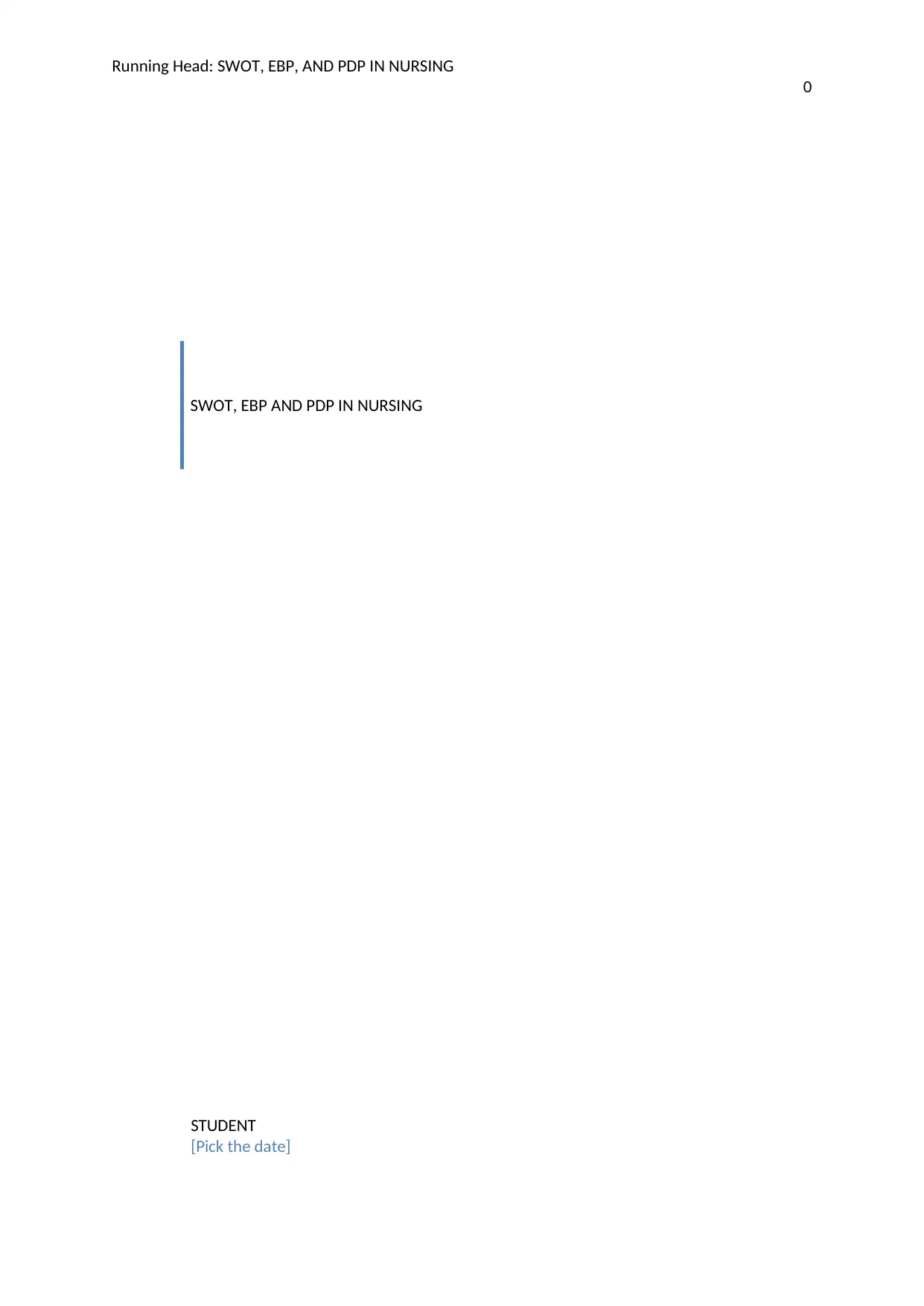
Running Head: SWOT, EBP, AND PDP IN NURSING
0
SWOT, EBP AND PDP IN NURSING
STUDENT
[Pick the date]
0
SWOT, EBP AND PDP IN NURSING
STUDENT
[Pick the date]
Paraphrase This Document
Need a fresh take? Get an instant paraphrase of this document with our AI Paraphraser
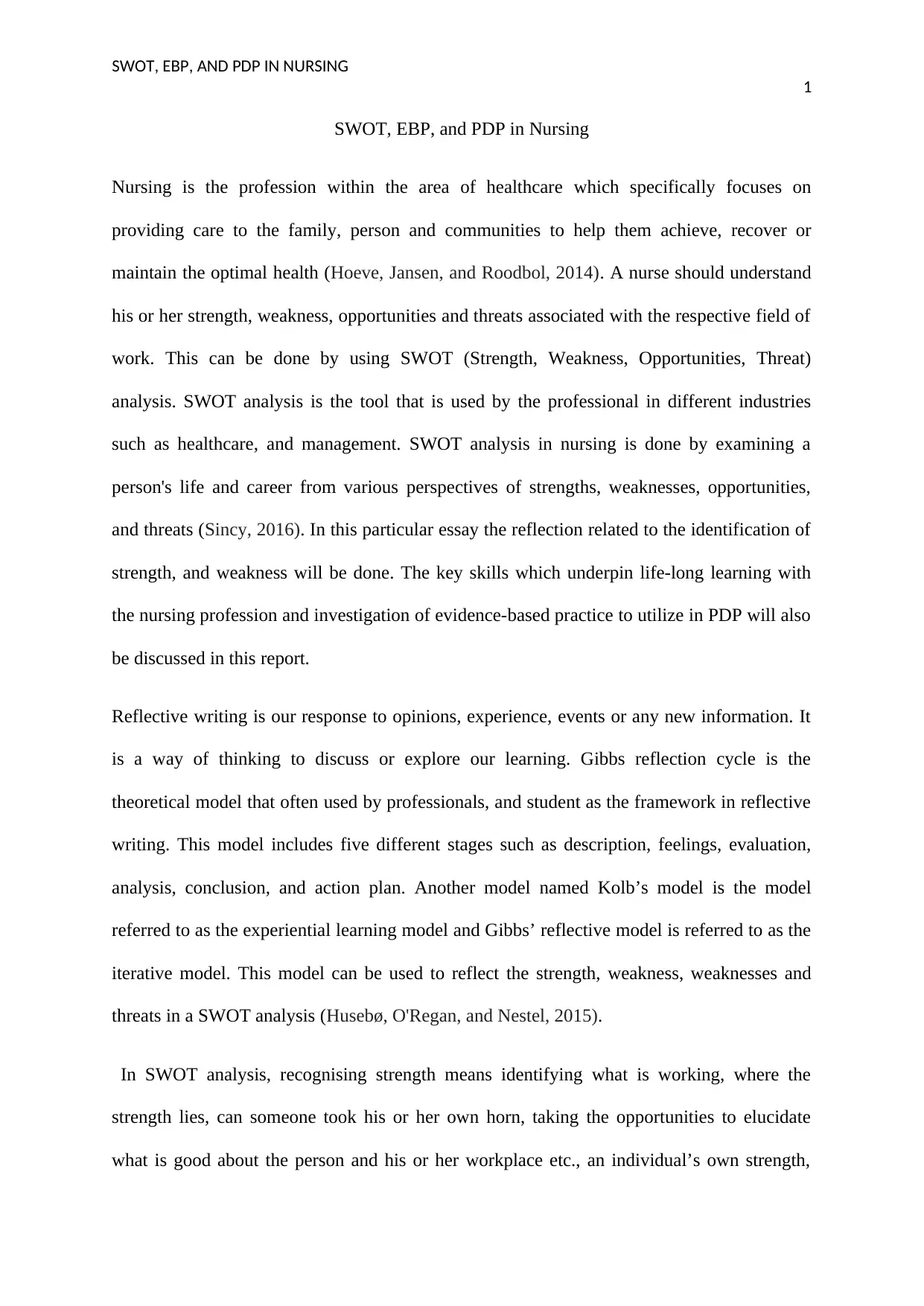
SWOT, EBP, AND PDP IN NURSING
1
SWOT, EBP, and PDP in Nursing
Nursing is the profession within the area of healthcare which specifically focuses on
providing care to the family, person and communities to help them achieve, recover or
maintain the optimal health (Hoeve, Jansen, and Roodbol, 2014). A nurse should understand
his or her strength, weakness, opportunities and threats associated with the respective field of
work. This can be done by using SWOT (Strength, Weakness, Opportunities, Threat)
analysis. SWOT analysis is the tool that is used by the professional in different industries
such as healthcare, and management. SWOT analysis in nursing is done by examining a
person's life and career from various perspectives of strengths, weaknesses, opportunities,
and threats (Sincy, 2016). In this particular essay the reflection related to the identification of
strength, and weakness will be done. The key skills which underpin life-long learning with
the nursing profession and investigation of evidence-based practice to utilize in PDP will also
be discussed in this report.
Reflective writing is our response to opinions, experience, events or any new information. It
is a way of thinking to discuss or explore our learning. Gibbs reflection cycle is the
theoretical model that often used by professionals, and student as the framework in reflective
writing. This model includes five different stages such as description, feelings, evaluation,
analysis, conclusion, and action plan. Another model named Kolb’s model is the model
referred to as the experiential learning model and Gibbs’ reflective model is referred to as the
iterative model. This model can be used to reflect the strength, weakness, weaknesses and
threats in a SWOT analysis (Husebø, O'Regan, and Nestel, 2015).
In SWOT analysis, recognising strength means identifying what is working, where the
strength lies, can someone took his or her own horn, taking the opportunities to elucidate
what is good about the person and his or her workplace etc., an individual’s own strength,
1
SWOT, EBP, and PDP in Nursing
Nursing is the profession within the area of healthcare which specifically focuses on
providing care to the family, person and communities to help them achieve, recover or
maintain the optimal health (Hoeve, Jansen, and Roodbol, 2014). A nurse should understand
his or her strength, weakness, opportunities and threats associated with the respective field of
work. This can be done by using SWOT (Strength, Weakness, Opportunities, Threat)
analysis. SWOT analysis is the tool that is used by the professional in different industries
such as healthcare, and management. SWOT analysis in nursing is done by examining a
person's life and career from various perspectives of strengths, weaknesses, opportunities,
and threats (Sincy, 2016). In this particular essay the reflection related to the identification of
strength, and weakness will be done. The key skills which underpin life-long learning with
the nursing profession and investigation of evidence-based practice to utilize in PDP will also
be discussed in this report.
Reflective writing is our response to opinions, experience, events or any new information. It
is a way of thinking to discuss or explore our learning. Gibbs reflection cycle is the
theoretical model that often used by professionals, and student as the framework in reflective
writing. This model includes five different stages such as description, feelings, evaluation,
analysis, conclusion, and action plan. Another model named Kolb’s model is the model
referred to as the experiential learning model and Gibbs’ reflective model is referred to as the
iterative model. This model can be used to reflect the strength, weakness, weaknesses and
threats in a SWOT analysis (Husebø, O'Regan, and Nestel, 2015).
In SWOT analysis, recognising strength means identifying what is working, where the
strength lies, can someone took his or her own horn, taking the opportunities to elucidate
what is good about the person and his or her workplace etc., an individual’s own strength,
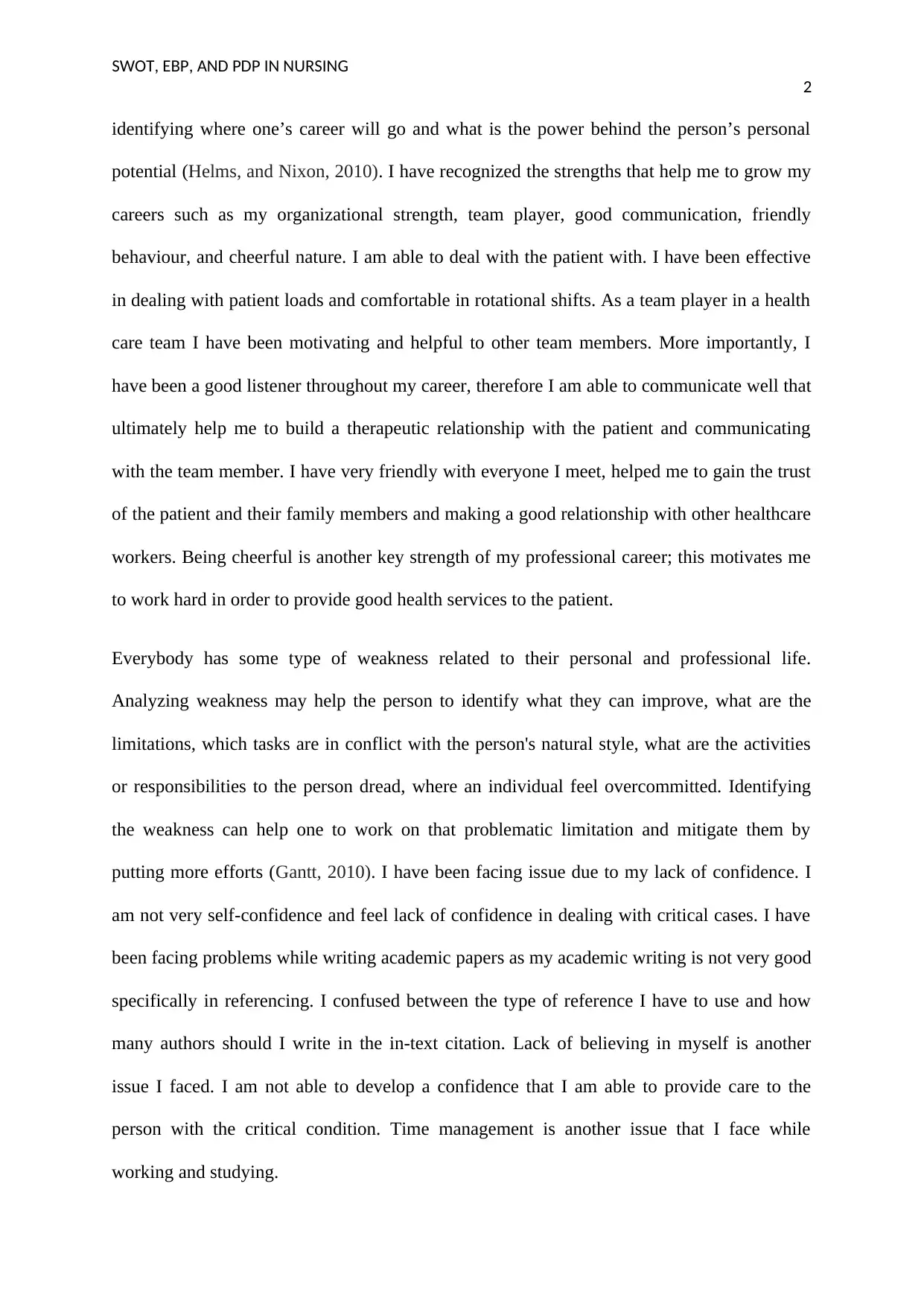
SWOT, EBP, AND PDP IN NURSING
2
identifying where one’s career will go and what is the power behind the person’s personal
potential (Helms, and Nixon, 2010). I have recognized the strengths that help me to grow my
careers such as my organizational strength, team player, good communication, friendly
behaviour, and cheerful nature. I am able to deal with the patient with. I have been effective
in dealing with patient loads and comfortable in rotational shifts. As a team player in a health
care team I have been motivating and helpful to other team members. More importantly, I
have been a good listener throughout my career, therefore I am able to communicate well that
ultimately help me to build a therapeutic relationship with the patient and communicating
with the team member. I have very friendly with everyone I meet, helped me to gain the trust
of the patient and their family members and making a good relationship with other healthcare
workers. Being cheerful is another key strength of my professional career; this motivates me
to work hard in order to provide good health services to the patient.
Everybody has some type of weakness related to their personal and professional life.
Analyzing weakness may help the person to identify what they can improve, what are the
limitations, which tasks are in conflict with the person's natural style, what are the activities
or responsibilities to the person dread, where an individual feel overcommitted. Identifying
the weakness can help one to work on that problematic limitation and mitigate them by
putting more efforts (Gantt, 2010). I have been facing issue due to my lack of confidence. I
am not very self-confidence and feel lack of confidence in dealing with critical cases. I have
been facing problems while writing academic papers as my academic writing is not very good
specifically in referencing. I confused between the type of reference I have to use and how
many authors should I write in the in-text citation. Lack of believing in myself is another
issue I faced. I am not able to develop a confidence that I am able to provide care to the
person with the critical condition. Time management is another issue that I face while
working and studying.
2
identifying where one’s career will go and what is the power behind the person’s personal
potential (Helms, and Nixon, 2010). I have recognized the strengths that help me to grow my
careers such as my organizational strength, team player, good communication, friendly
behaviour, and cheerful nature. I am able to deal with the patient with. I have been effective
in dealing with patient loads and comfortable in rotational shifts. As a team player in a health
care team I have been motivating and helpful to other team members. More importantly, I
have been a good listener throughout my career, therefore I am able to communicate well that
ultimately help me to build a therapeutic relationship with the patient and communicating
with the team member. I have very friendly with everyone I meet, helped me to gain the trust
of the patient and their family members and making a good relationship with other healthcare
workers. Being cheerful is another key strength of my professional career; this motivates me
to work hard in order to provide good health services to the patient.
Everybody has some type of weakness related to their personal and professional life.
Analyzing weakness may help the person to identify what they can improve, what are the
limitations, which tasks are in conflict with the person's natural style, what are the activities
or responsibilities to the person dread, where an individual feel overcommitted. Identifying
the weakness can help one to work on that problematic limitation and mitigate them by
putting more efforts (Gantt, 2010). I have been facing issue due to my lack of confidence. I
am not very self-confidence and feel lack of confidence in dealing with critical cases. I have
been facing problems while writing academic papers as my academic writing is not very good
specifically in referencing. I confused between the type of reference I have to use and how
many authors should I write in the in-text citation. Lack of believing in myself is another
issue I faced. I am not able to develop a confidence that I am able to provide care to the
person with the critical condition. Time management is another issue that I face while
working and studying.
⊘ This is a preview!⊘
Do you want full access?
Subscribe today to unlock all pages.

Trusted by 1+ million students worldwide
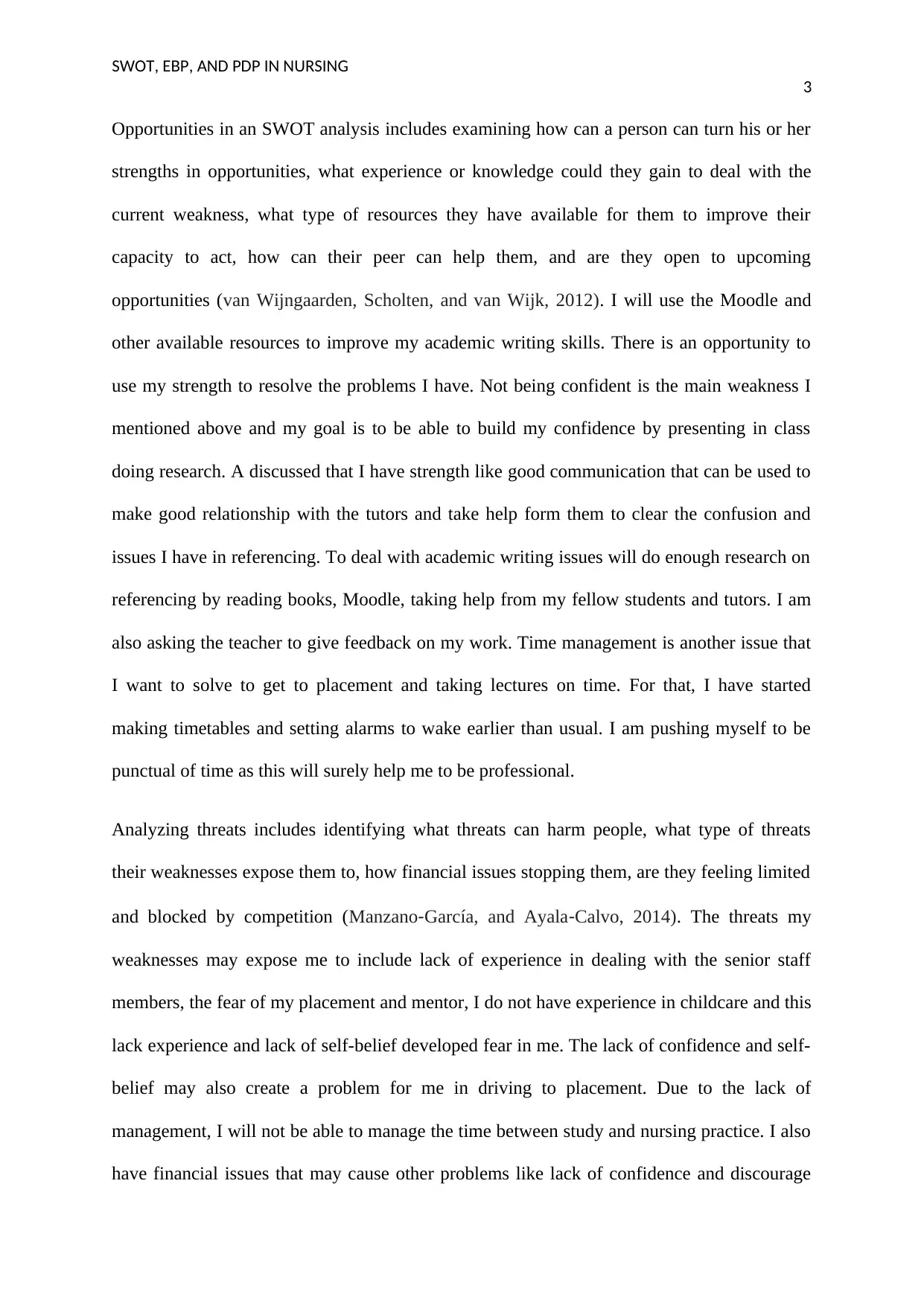
SWOT, EBP, AND PDP IN NURSING
3
Opportunities in an SWOT analysis includes examining how can a person can turn his or her
strengths in opportunities, what experience or knowledge could they gain to deal with the
current weakness, what type of resources they have available for them to improve their
capacity to act, how can their peer can help them, and are they open to upcoming
opportunities (van Wijngaarden, Scholten, and van Wijk, 2012). I will use the Moodle and
other available resources to improve my academic writing skills. There is an opportunity to
use my strength to resolve the problems I have. Not being confident is the main weakness I
mentioned above and my goal is to be able to build my confidence by presenting in class
doing research. A discussed that I have strength like good communication that can be used to
make good relationship with the tutors and take help form them to clear the confusion and
issues I have in referencing. To deal with academic writing issues will do enough research on
referencing by reading books, Moodle, taking help from my fellow students and tutors. I am
also asking the teacher to give feedback on my work. Time management is another issue that
I want to solve to get to placement and taking lectures on time. For that, I have started
making timetables and setting alarms to wake earlier than usual. I am pushing myself to be
punctual of time as this will surely help me to be professional.
Analyzing threats includes identifying what threats can harm people, what type of threats
their weaknesses expose them to, how financial issues stopping them, are they feeling limited
and blocked by competition (Manzano‐García, and Ayala‐Calvo, 2014). The threats my
weaknesses may expose me to include lack of experience in dealing with the senior staff
members, the fear of my placement and mentor, I do not have experience in childcare and this
lack experience and lack of self-belief developed fear in me. The lack of confidence and self-
belief may also create a problem for me in driving to placement. Due to the lack of
management, I will not be able to manage the time between study and nursing practice. I also
have financial issues that may cause other problems like lack of confidence and discourage
3
Opportunities in an SWOT analysis includes examining how can a person can turn his or her
strengths in opportunities, what experience or knowledge could they gain to deal with the
current weakness, what type of resources they have available for them to improve their
capacity to act, how can their peer can help them, and are they open to upcoming
opportunities (van Wijngaarden, Scholten, and van Wijk, 2012). I will use the Moodle and
other available resources to improve my academic writing skills. There is an opportunity to
use my strength to resolve the problems I have. Not being confident is the main weakness I
mentioned above and my goal is to be able to build my confidence by presenting in class
doing research. A discussed that I have strength like good communication that can be used to
make good relationship with the tutors and take help form them to clear the confusion and
issues I have in referencing. To deal with academic writing issues will do enough research on
referencing by reading books, Moodle, taking help from my fellow students and tutors. I am
also asking the teacher to give feedback on my work. Time management is another issue that
I want to solve to get to placement and taking lectures on time. For that, I have started
making timetables and setting alarms to wake earlier than usual. I am pushing myself to be
punctual of time as this will surely help me to be professional.
Analyzing threats includes identifying what threats can harm people, what type of threats
their weaknesses expose them to, how financial issues stopping them, are they feeling limited
and blocked by competition (Manzano‐García, and Ayala‐Calvo, 2014). The threats my
weaknesses may expose me to include lack of experience in dealing with the senior staff
members, the fear of my placement and mentor, I do not have experience in childcare and this
lack experience and lack of self-belief developed fear in me. The lack of confidence and self-
belief may also create a problem for me in driving to placement. Due to the lack of
management, I will not be able to manage the time between study and nursing practice. I also
have financial issues that may cause other problems like lack of confidence and discourage
Paraphrase This Document
Need a fresh take? Get an instant paraphrase of this document with our AI Paraphraser
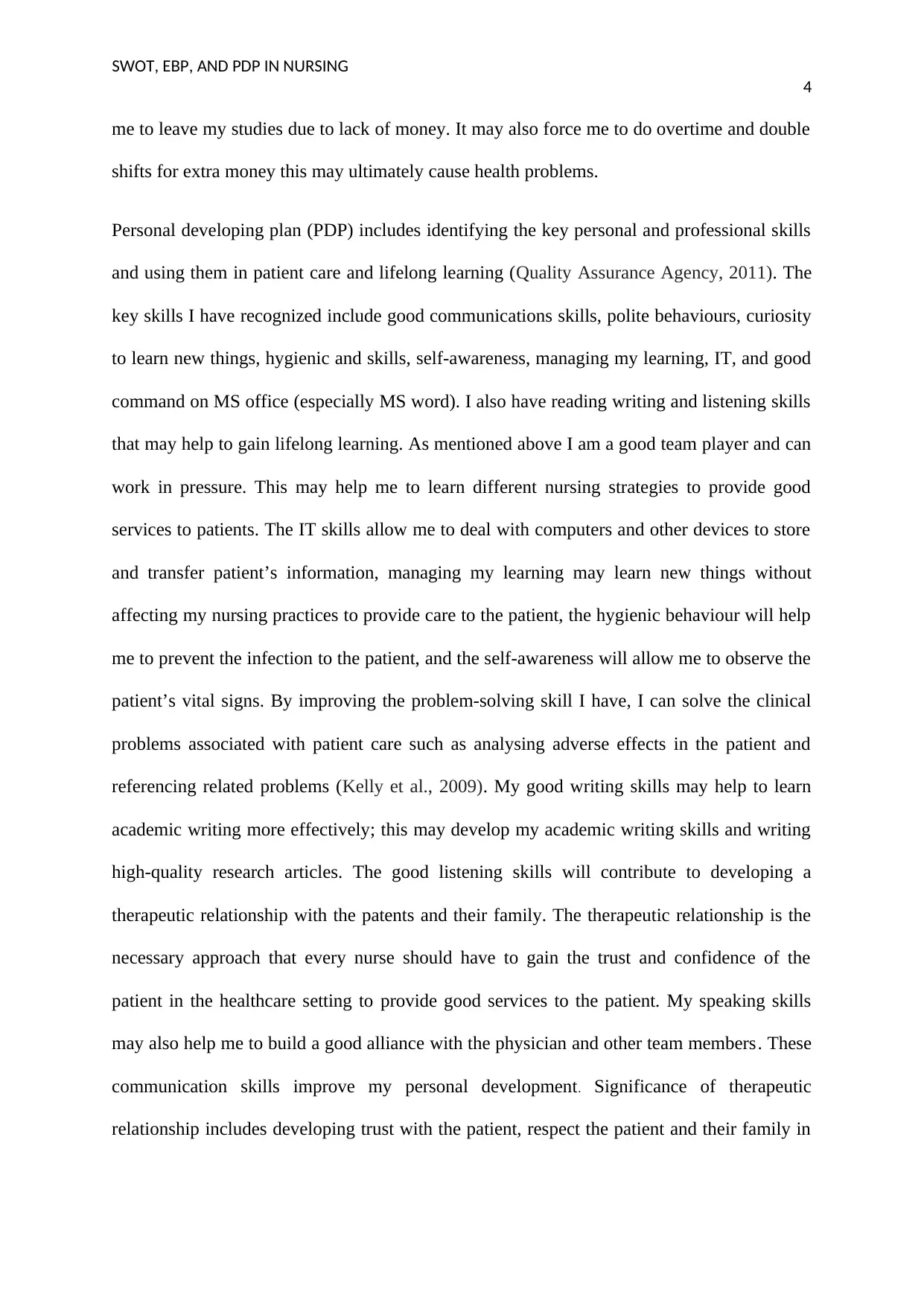
SWOT, EBP, AND PDP IN NURSING
4
me to leave my studies due to lack of money. It may also force me to do overtime and double
shifts for extra money this may ultimately cause health problems.
Personal developing plan (PDP) includes identifying the key personal and professional skills
and using them in patient care and lifelong learning (Quality Assurance Agency, 2011). The
key skills I have recognized include good communications skills, polite behaviours, curiosity
to learn new things, hygienic and skills, self-awareness, managing my learning, IT, and good
command on MS office (especially MS word). I also have reading writing and listening skills
that may help to gain lifelong learning. As mentioned above I am a good team player and can
work in pressure. This may help me to learn different nursing strategies to provide good
services to patients. The IT skills allow me to deal with computers and other devices to store
and transfer patient’s information, managing my learning may learn new things without
affecting my nursing practices to provide care to the patient, the hygienic behaviour will help
me to prevent the infection to the patient, and the self-awareness will allow me to observe the
patient’s vital signs. By improving the problem-solving skill I have, I can solve the clinical
problems associated with patient care such as analysing adverse effects in the patient and
referencing related problems (Kelly et al., 2009). My good writing skills may help to learn
academic writing more effectively; this may develop my academic writing skills and writing
high-quality research articles. The good listening skills will contribute to developing a
therapeutic relationship with the patents and their family. The therapeutic relationship is the
necessary approach that every nurse should have to gain the trust and confidence of the
patient in the healthcare setting to provide good services to the patient. My speaking skills
may also help me to build a good alliance with the physician and other team members. These
communication skills improve my personal development. Significance of therapeutic
relationship includes developing trust with the patient, respect the patient and their family in
4
me to leave my studies due to lack of money. It may also force me to do overtime and double
shifts for extra money this may ultimately cause health problems.
Personal developing plan (PDP) includes identifying the key personal and professional skills
and using them in patient care and lifelong learning (Quality Assurance Agency, 2011). The
key skills I have recognized include good communications skills, polite behaviours, curiosity
to learn new things, hygienic and skills, self-awareness, managing my learning, IT, and good
command on MS office (especially MS word). I also have reading writing and listening skills
that may help to gain lifelong learning. As mentioned above I am a good team player and can
work in pressure. This may help me to learn different nursing strategies to provide good
services to patients. The IT skills allow me to deal with computers and other devices to store
and transfer patient’s information, managing my learning may learn new things without
affecting my nursing practices to provide care to the patient, the hygienic behaviour will help
me to prevent the infection to the patient, and the self-awareness will allow me to observe the
patient’s vital signs. By improving the problem-solving skill I have, I can solve the clinical
problems associated with patient care such as analysing adverse effects in the patient and
referencing related problems (Kelly et al., 2009). My good writing skills may help to learn
academic writing more effectively; this may develop my academic writing skills and writing
high-quality research articles. The good listening skills will contribute to developing a
therapeutic relationship with the patents and their family. The therapeutic relationship is the
necessary approach that every nurse should have to gain the trust and confidence of the
patient in the healthcare setting to provide good services to the patient. My speaking skills
may also help me to build a good alliance with the physician and other team members. These
communication skills improve my personal development. Significance of therapeutic
relationship includes developing trust with the patient, respect the patient and their family in
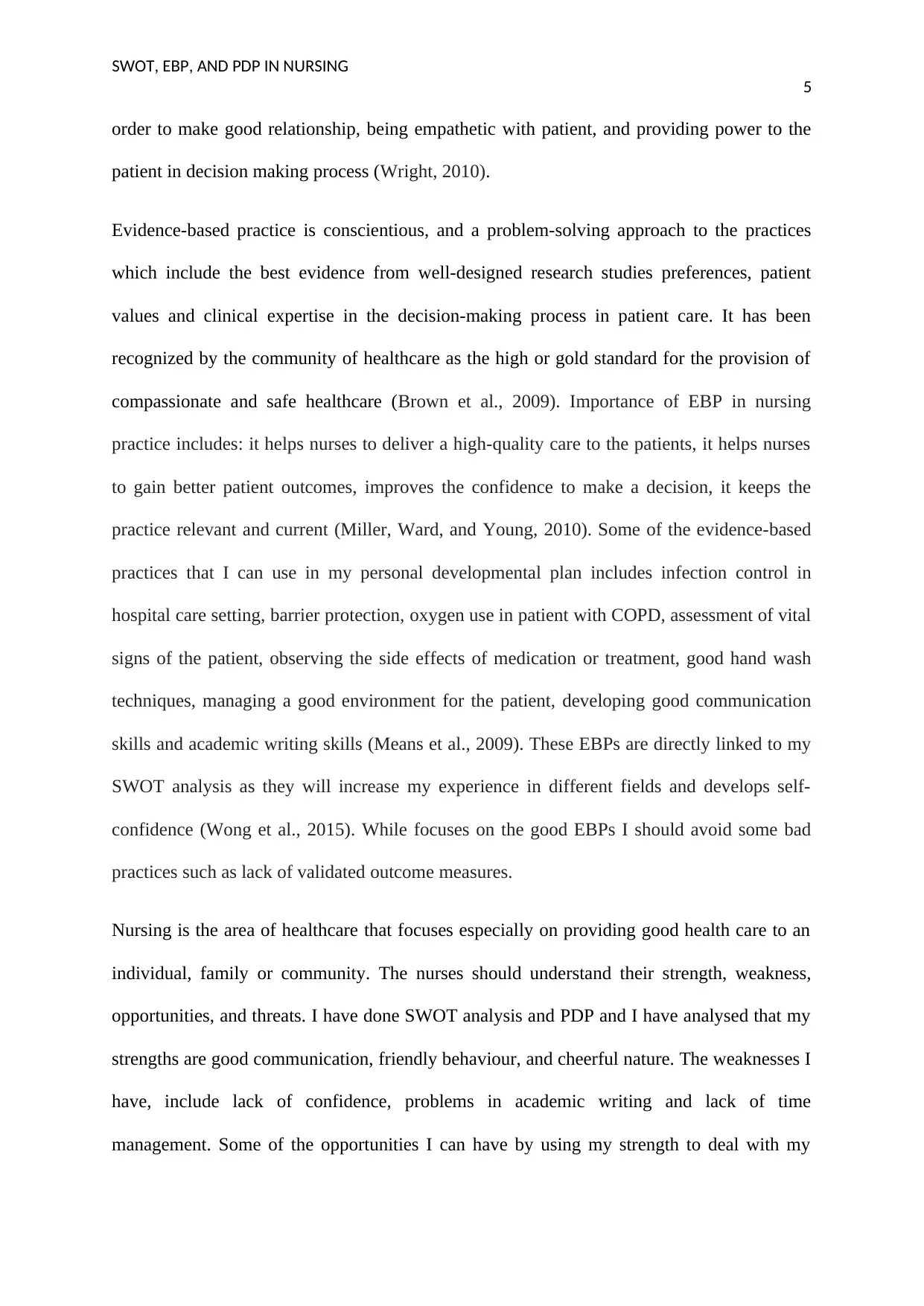
SWOT, EBP, AND PDP IN NURSING
5
order to make good relationship, being empathetic with patient, and providing power to the
patient in decision making process (Wright, 2010).
Evidence-based practice is conscientious, and a problem-solving approach to the practices
which include the best evidence from well-designed research studies preferences, patient
values and clinical expertise in the decision-making process in patient care. It has been
recognized by the community of healthcare as the high or gold standard for the provision of
compassionate and safe healthcare (Brown et al., 2009). Importance of EBP in nursing
practice includes: it helps nurses to deliver a high-quality care to the patients, it helps nurses
to gain better patient outcomes, improves the confidence to make a decision, it keeps the
practice relevant and current (Miller, Ward, and Young, 2010). Some of the evidence-based
practices that I can use in my personal developmental plan includes infection control in
hospital care setting, barrier protection, oxygen use in patient with COPD, assessment of vital
signs of the patient, observing the side effects of medication or treatment, good hand wash
techniques, managing a good environment for the patient, developing good communication
skills and academic writing skills (Means et al., 2009). These EBPs are directly linked to my
SWOT analysis as they will increase my experience in different fields and develops self-
confidence (Wong et al., 2015). While focuses on the good EBPs I should avoid some bad
practices such as lack of validated outcome measures.
Nursing is the area of healthcare that focuses especially on providing good health care to an
individual, family or community. The nurses should understand their strength, weakness,
opportunities, and threats. I have done SWOT analysis and PDP and I have analysed that my
strengths are good communication, friendly behaviour, and cheerful nature. The weaknesses I
have, include lack of confidence, problems in academic writing and lack of time
management. Some of the opportunities I can have by using my strength to deal with my
5
order to make good relationship, being empathetic with patient, and providing power to the
patient in decision making process (Wright, 2010).
Evidence-based practice is conscientious, and a problem-solving approach to the practices
which include the best evidence from well-designed research studies preferences, patient
values and clinical expertise in the decision-making process in patient care. It has been
recognized by the community of healthcare as the high or gold standard for the provision of
compassionate and safe healthcare (Brown et al., 2009). Importance of EBP in nursing
practice includes: it helps nurses to deliver a high-quality care to the patients, it helps nurses
to gain better patient outcomes, improves the confidence to make a decision, it keeps the
practice relevant and current (Miller, Ward, and Young, 2010). Some of the evidence-based
practices that I can use in my personal developmental plan includes infection control in
hospital care setting, barrier protection, oxygen use in patient with COPD, assessment of vital
signs of the patient, observing the side effects of medication or treatment, good hand wash
techniques, managing a good environment for the patient, developing good communication
skills and academic writing skills (Means et al., 2009). These EBPs are directly linked to my
SWOT analysis as they will increase my experience in different fields and develops self-
confidence (Wong et al., 2015). While focuses on the good EBPs I should avoid some bad
practices such as lack of validated outcome measures.
Nursing is the area of healthcare that focuses especially on providing good health care to an
individual, family or community. The nurses should understand their strength, weakness,
opportunities, and threats. I have done SWOT analysis and PDP and I have analysed that my
strengths are good communication, friendly behaviour, and cheerful nature. The weaknesses I
have, include lack of confidence, problems in academic writing and lack of time
management. Some of the opportunities I can have by using my strength to deal with my
⊘ This is a preview!⊘
Do you want full access?
Subscribe today to unlock all pages.

Trusted by 1+ million students worldwide
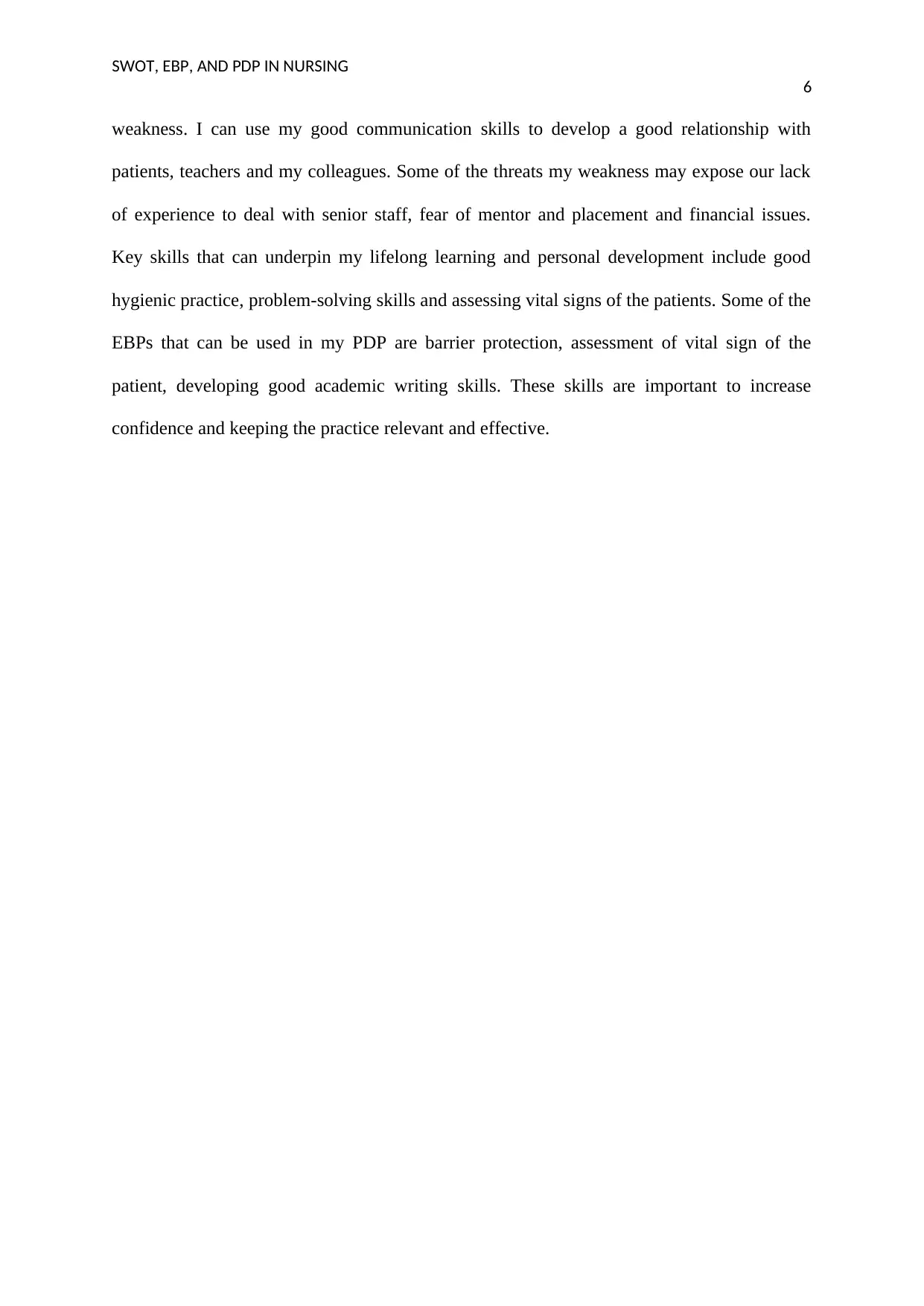
SWOT, EBP, AND PDP IN NURSING
6
weakness. I can use my good communication skills to develop a good relationship with
patients, teachers and my colleagues. Some of the threats my weakness may expose our lack
of experience to deal with senior staff, fear of mentor and placement and financial issues.
Key skills that can underpin my lifelong learning and personal development include good
hygienic practice, problem-solving skills and assessing vital signs of the patients. Some of the
EBPs that can be used in my PDP are barrier protection, assessment of vital sign of the
patient, developing good academic writing skills. These skills are important to increase
confidence and keeping the practice relevant and effective.
6
weakness. I can use my good communication skills to develop a good relationship with
patients, teachers and my colleagues. Some of the threats my weakness may expose our lack
of experience to deal with senior staff, fear of mentor and placement and financial issues.
Key skills that can underpin my lifelong learning and personal development include good
hygienic practice, problem-solving skills and assessing vital signs of the patients. Some of the
EBPs that can be used in my PDP are barrier protection, assessment of vital sign of the
patient, developing good academic writing skills. These skills are important to increase
confidence and keeping the practice relevant and effective.
Paraphrase This Document
Need a fresh take? Get an instant paraphrase of this document with our AI Paraphraser
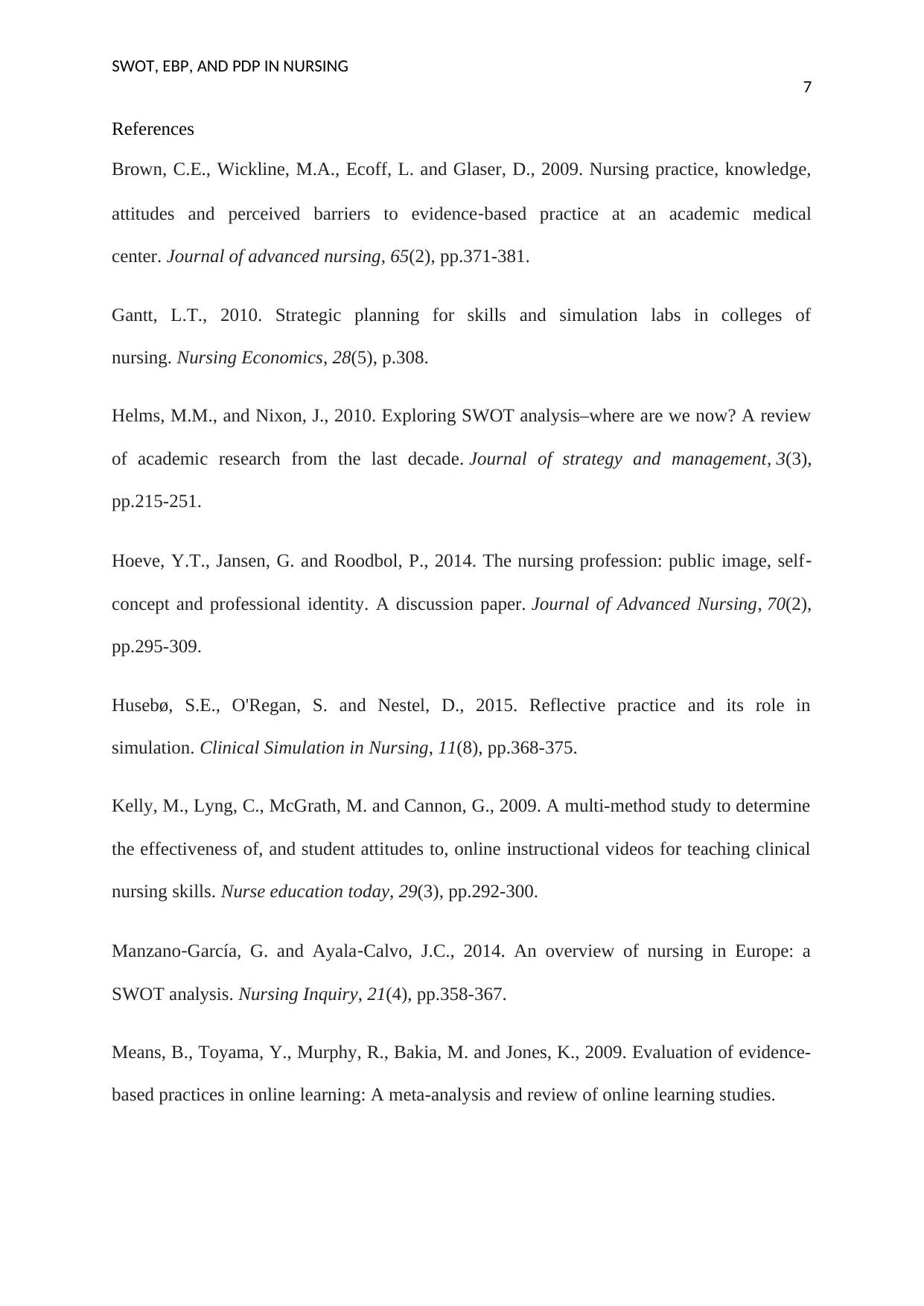
SWOT, EBP, AND PDP IN NURSING
7
References
Brown, C.E., Wickline, M.A., Ecoff, L. and Glaser, D., 2009. Nursing practice, knowledge,
attitudes and perceived barriers to evidence‐based practice at an academic medical
center. Journal of advanced nursing, 65(2), pp.371-381.
Gantt, L.T., 2010. Strategic planning for skills and simulation labs in colleges of
nursing. Nursing Economics, 28(5), p.308.
Helms, M.M., and Nixon, J., 2010. Exploring SWOT analysis–where are we now? A review
of academic research from the last decade. Journal of strategy and management, 3(3),
pp.215-251.
Hoeve, Y.T., Jansen, G. and Roodbol, P., 2014. The nursing profession: public image, self‐
concept and professional identity. A discussion paper. Journal of Advanced Nursing, 70(2),
pp.295-309.
Husebø, S.E., O'Regan, S. and Nestel, D., 2015. Reflective practice and its role in
simulation. Clinical Simulation in Nursing, 11(8), pp.368-375.
Kelly, M., Lyng, C., McGrath, M. and Cannon, G., 2009. A multi-method study to determine
the effectiveness of, and student attitudes to, online instructional videos for teaching clinical
nursing skills. Nurse education today, 29(3), pp.292-300.
Manzano‐García, G. and Ayala‐Calvo, J.C., 2014. An overview of nursing in Europe: a
SWOT analysis. Nursing Inquiry, 21(4), pp.358-367.
Means, B., Toyama, Y., Murphy, R., Bakia, M. and Jones, K., 2009. Evaluation of evidence-
based practices in online learning: A meta-analysis and review of online learning studies.
7
References
Brown, C.E., Wickline, M.A., Ecoff, L. and Glaser, D., 2009. Nursing practice, knowledge,
attitudes and perceived barriers to evidence‐based practice at an academic medical
center. Journal of advanced nursing, 65(2), pp.371-381.
Gantt, L.T., 2010. Strategic planning for skills and simulation labs in colleges of
nursing. Nursing Economics, 28(5), p.308.
Helms, M.M., and Nixon, J., 2010. Exploring SWOT analysis–where are we now? A review
of academic research from the last decade. Journal of strategy and management, 3(3),
pp.215-251.
Hoeve, Y.T., Jansen, G. and Roodbol, P., 2014. The nursing profession: public image, self‐
concept and professional identity. A discussion paper. Journal of Advanced Nursing, 70(2),
pp.295-309.
Husebø, S.E., O'Regan, S. and Nestel, D., 2015. Reflective practice and its role in
simulation. Clinical Simulation in Nursing, 11(8), pp.368-375.
Kelly, M., Lyng, C., McGrath, M. and Cannon, G., 2009. A multi-method study to determine
the effectiveness of, and student attitudes to, online instructional videos for teaching clinical
nursing skills. Nurse education today, 29(3), pp.292-300.
Manzano‐García, G. and Ayala‐Calvo, J.C., 2014. An overview of nursing in Europe: a
SWOT analysis. Nursing Inquiry, 21(4), pp.358-367.
Means, B., Toyama, Y., Murphy, R., Bakia, M. and Jones, K., 2009. Evaluation of evidence-
based practices in online learning: A meta-analysis and review of online learning studies.
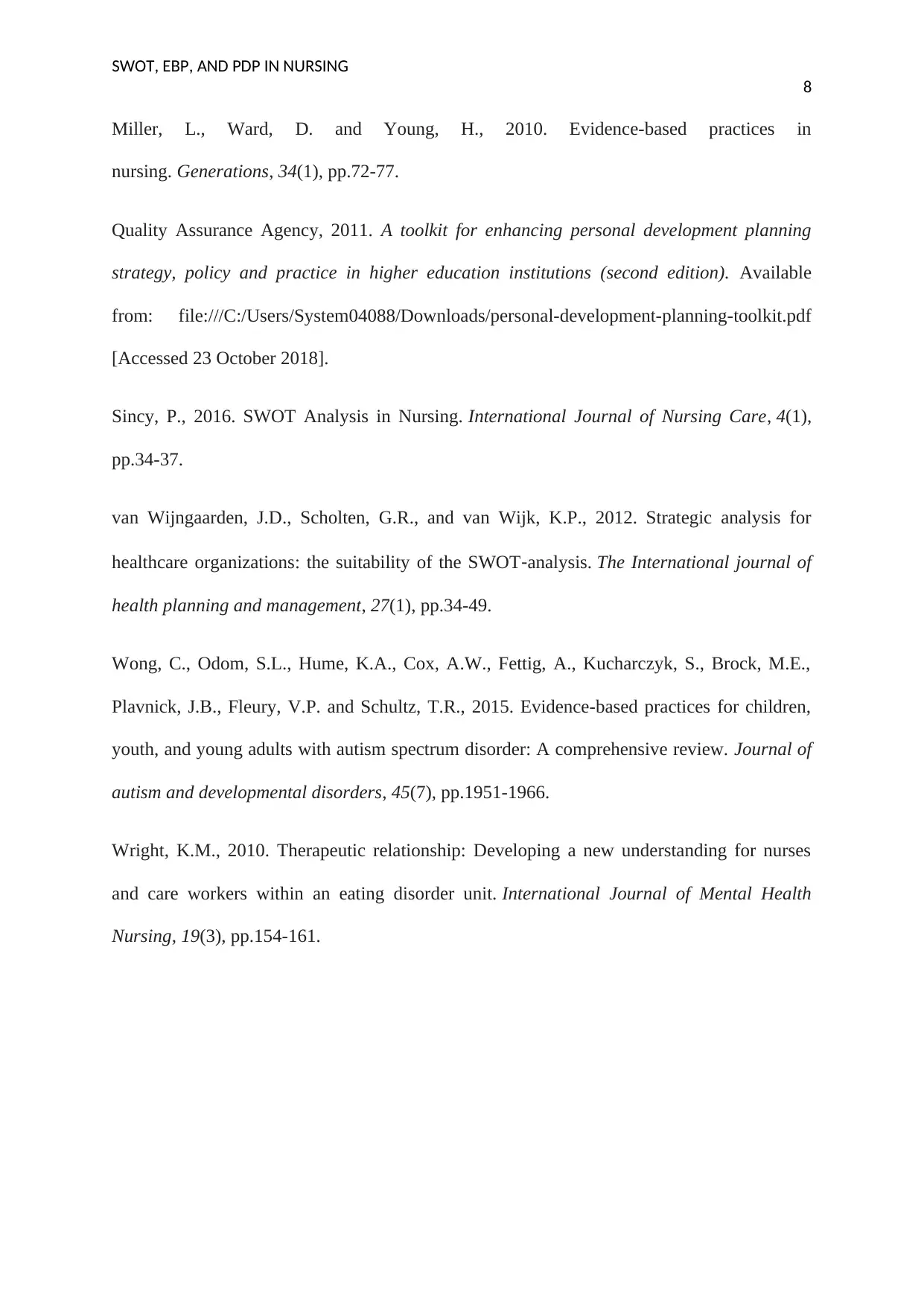
SWOT, EBP, AND PDP IN NURSING
8
Miller, L., Ward, D. and Young, H., 2010. Evidence-based practices in
nursing. Generations, 34(1), pp.72-77.
Quality Assurance Agency, 2011. A toolkit for enhancing personal development planning
strategy, policy and practice in higher education institutions (second edition). Available
from: file:///C:/Users/System04088/Downloads/personal-development-planning-toolkit.pdf
[Accessed 23 October 2018].
Sincy, P., 2016. SWOT Analysis in Nursing. International Journal of Nursing Care, 4(1),
pp.34-37.
van Wijngaarden, J.D., Scholten, G.R., and van Wijk, K.P., 2012. Strategic analysis for
healthcare organizations: the suitability of the SWOT‐analysis. The International journal of
health planning and management, 27(1), pp.34-49.
Wong, C., Odom, S.L., Hume, K.A., Cox, A.W., Fettig, A., Kucharczyk, S., Brock, M.E.,
Plavnick, J.B., Fleury, V.P. and Schultz, T.R., 2015. Evidence-based practices for children,
youth, and young adults with autism spectrum disorder: A comprehensive review. Journal of
autism and developmental disorders, 45(7), pp.1951-1966.
Wright, K.M., 2010. Therapeutic relationship: Developing a new understanding for nurses
and care workers within an eating disorder unit. International Journal of Mental Health
Nursing, 19(3), pp.154-161.
8
Miller, L., Ward, D. and Young, H., 2010. Evidence-based practices in
nursing. Generations, 34(1), pp.72-77.
Quality Assurance Agency, 2011. A toolkit for enhancing personal development planning
strategy, policy and practice in higher education institutions (second edition). Available
from: file:///C:/Users/System04088/Downloads/personal-development-planning-toolkit.pdf
[Accessed 23 October 2018].
Sincy, P., 2016. SWOT Analysis in Nursing. International Journal of Nursing Care, 4(1),
pp.34-37.
van Wijngaarden, J.D., Scholten, G.R., and van Wijk, K.P., 2012. Strategic analysis for
healthcare organizations: the suitability of the SWOT‐analysis. The International journal of
health planning and management, 27(1), pp.34-49.
Wong, C., Odom, S.L., Hume, K.A., Cox, A.W., Fettig, A., Kucharczyk, S., Brock, M.E.,
Plavnick, J.B., Fleury, V.P. and Schultz, T.R., 2015. Evidence-based practices for children,
youth, and young adults with autism spectrum disorder: A comprehensive review. Journal of
autism and developmental disorders, 45(7), pp.1951-1966.
Wright, K.M., 2010. Therapeutic relationship: Developing a new understanding for nurses
and care workers within an eating disorder unit. International Journal of Mental Health
Nursing, 19(3), pp.154-161.
⊘ This is a preview!⊘
Do you want full access?
Subscribe today to unlock all pages.

Trusted by 1+ million students worldwide
1 out of 9
Related Documents
Your All-in-One AI-Powered Toolkit for Academic Success.
+13062052269
info@desklib.com
Available 24*7 on WhatsApp / Email
![[object Object]](/_next/static/media/star-bottom.7253800d.svg)
Unlock your academic potential
Copyright © 2020–2025 A2Z Services. All Rights Reserved. Developed and managed by ZUCOL.





